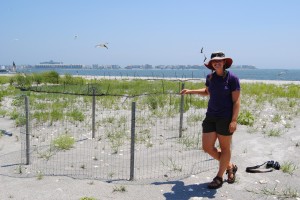If At First You Don’t Succeed, Try, Try and Try Again!
Migrating with Piping Plovers
By Emily Heiser, Field Technician

There is not too much more we could have guessed would happen to a particular pair of piping plovers that nested at the North Brigantine Natural Area (NBNA) this season. Every time one of the staff members ventured out to NBNA, it seemed as though a soap opera was unfolding with dramatic twists and turns to the story! Disturbance, flooding, and the infamous Brigantine foxes were all to blame for the failure of three nests that a single pair of plovers laid. And just when we thought this pair was done for the season, they surprised us by laying their fourth nest! Over the course of two months, this very special pair of piping plovers determinedly laid 14 eggs!
You may ask, how do we know this is the same pair nesting all four times? We were very lucky because the female in this pair is a banded bird. Most of the East Coast population of piping plovers has remained unbanded for over 30 years due to complications with banding in the 1980’s. Recently, banding has begun again on the wintering habitats of theBahamasand theGulfCoast, which has allowed us to re-sight banded “Pipers” on their breeding grounds. Our NBNA plover is adorned with four small plastic bands on the upper and lower portions of her legs. These small plastic bands may seem trivial, however they provide important information and research when reported. For instance, we know that she was banded in the winter of 2010 in theBahamas, she nested last summer in a very similar spot as this year – successfully rearing four chicks – and we were able to determine that she is the female in the pair. Piping plovers have very little sexual dimorphism or observable differences between males and females. In finding out that this special bird was a female; we quickly dubbed her our Bahama Mama!
Monitoring our New Jerseypairs throughout the breeding season has been a culmination of sorts of the last year for myself. From August 2010 to April 2011, I was working with Virginia Tech and the U.S. Fish and Wildlife Service on a large mark-recapture study that focused on the effects of the BP Deepwater Horizon Oil Spill on piping plovers. Our study sites included barrier islands and marsh flats fromTexastoGeorgia. Working with a crew stationed out ofDauphin Island,AlabamaI traveled out to many of the islands in the Gulf Islands National Seashore. This was not only provided me with a first hand view of the effects of theUS’s largest oil spill, but it also broaded my understanding and appreciation of piping plovers and their wintering habitats. Spending almost eight months out of the year on their wintering grounds, observing their patterns and behaviors is something I’ve carried with me into the breeding season.
Interestingly enough, watching the plovers now as they are preparing to make their long journey south is very remindful of observing their habits on their wintering grounds. As spring migration came about a colleague informed me that the restless, anxious behavior the birds were showing was called “zugunruhe”. A German word that breaks down into “zug” meaning move, migration and “ruhue” meaning anxiety, restlessness. As the breeding season is quickly coming to a close the breeding hormones are slowly subsiding and the plovers are focusing more on feeding and “bulking up” for their long journey south.
As the saga of our NBNA banded plover pair continues, I must admit my own fears that perhaps our Bahama Mama may too feel the desire to migrate slowly creeping into her system and perhaps not feel quite as attached to her new chicks. However, her tenacity and determination to hatch out her brood gives me hope that she will in fact succeed! As I was writing this I was happily surprised to find out that Bahama Mama’s fourth nest has hatched out two chicks! In three weeks time, I look forward to seeing her with some fledglings Bahamas bound!
Discover more from Conserve Wildlife Foundation of NJ
Subscribe to get the latest posts sent to your email.